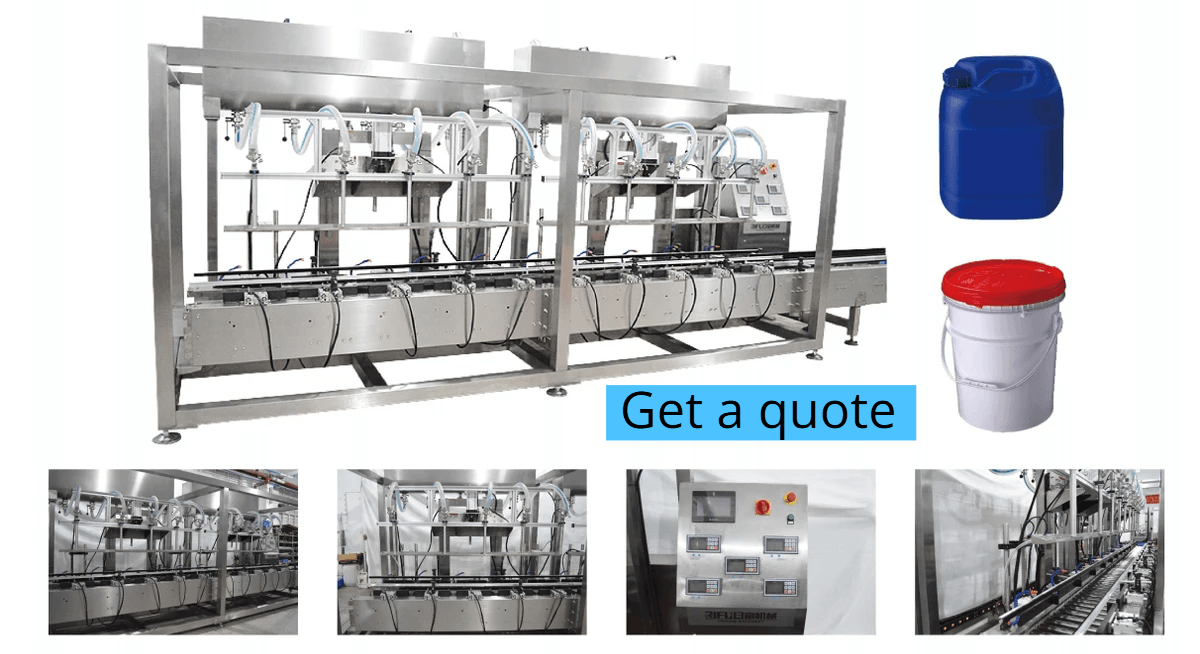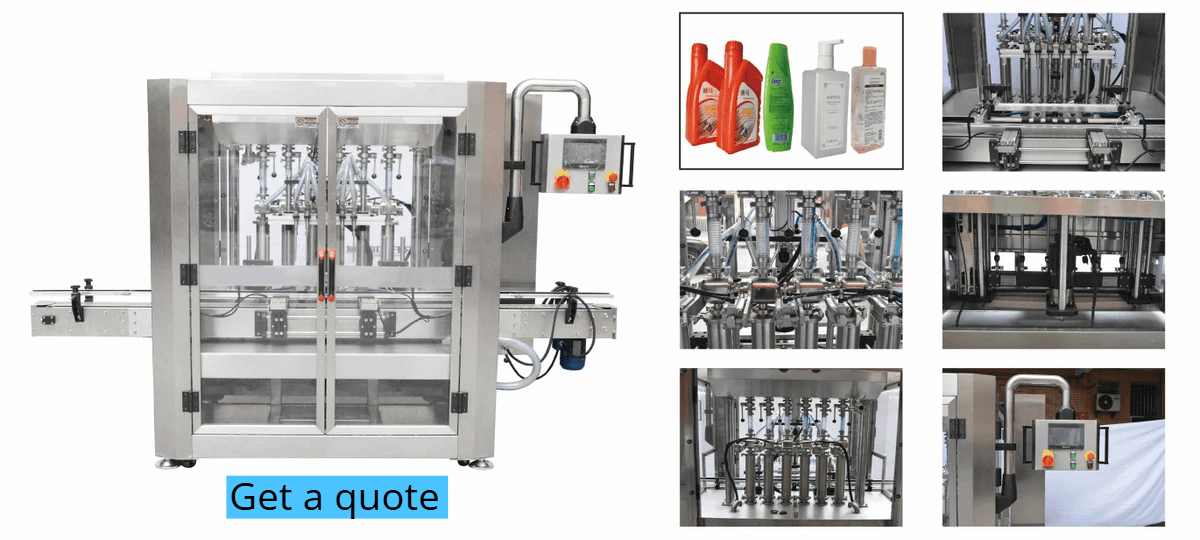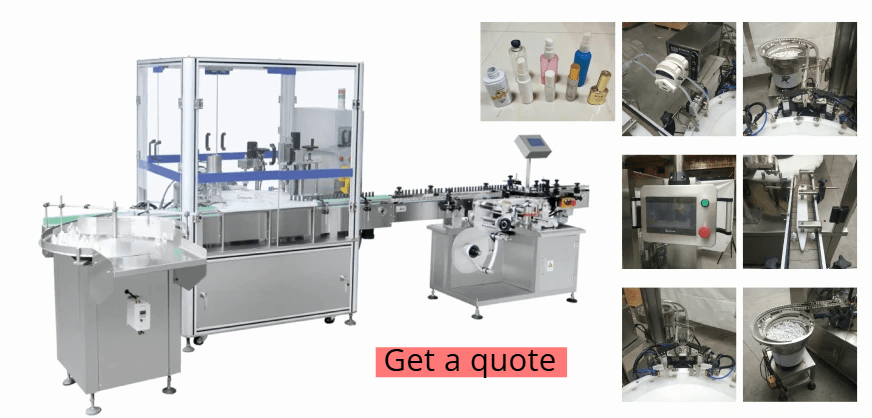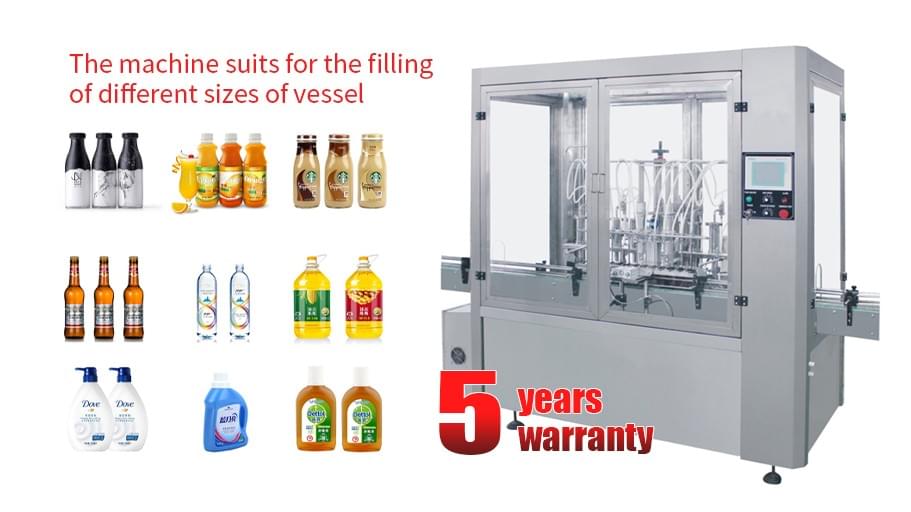Volumetric filling machines measure and fill a fixed volume of liquid or semi-liquid liquid into a container (bottle, can, tube, or bag). How it works : The mechanical structure of a volumetric filler is pre-set to a fixed volume . The liquid delivered by the filler occupies the same volume with each operation, ensuring consistent fill volume.
However, this filling method has a flaw. It cannot recognize changes in product characteristics and will only fill the same volume, resulting in deviations in the final product weight. For example, heated syrup may slightly decrease in volume after cooling . For liquids that easily foam (such as shampoo and beer), foam will occupy part of the volume, resulting in insufficient liquid being filled. For volatile liquids, evaporation can also lead to inaccurate filling quantities. Therefore, volumetric fillers are not suitable for filling such products, or filling should be carried out under conditions that avoid such situations as much as possible.
Given these drawbacks, why would a volumetric filler be chosen for filling? Wouldn't a gravimetric filler be a better option?
Volumetric filling machines exist for a reason. Their mechanical structure is relatively traditional and simple, resulting in generally low manufacturing costs . When filling liquids with stable physical properties, they can be used for large-scale production with high filling accuracy, offering a high cost-effectiveness ratio . They are widely used in the pharmaceutical, cosmetic, food and beverage, and chemical industries . Products such as mineral water, juice, milk, edible oil, alcohol, and detergents are well-suited for this type of filling machine .
Gravimetric filling machines are generally better, offering higher filling accuracy and being unaffected by the physical properties of the product. However, the equipment is more expensive to manufacture. Choosing one depends on your budget and needs.
Types of Volumetric Filling Machines
Volumetric filling
involves filling a fixed volume of liquid into a container. There are many different filling methods, including reciprocating motion of a piston within a cylinder , pumping, and gravity-fed filling. Volumetric filling machines can be categorized by their filling method into piston fillers, pump fillers, and gravity-fed volumetric fillers.
Gravity filling machine
Gravity filling machines rely on the liquid's own gravity to flow into the container, maintaining a consistent volume through a controlled liquid level or metering cup . They are typically very simple and are suitable for thin, free-flowing liquids. The product is stored above the filling nozzle in a hopper or tank; filling is controlled by gravity and is typically timed or controlled by a level sensor in the nozzle. However, viscous liquids or products containing fibers or suspended solids, such as syrups, creams, or sauces , tend to flow poorly and are not suitable for gravity volumetric filling.
1. Measuring cup filling machine : This machine is equipped with one or more measuring cups with precisely pre-set volumes . During operation, material flows from the upper storage hopper into the measuring cup until it is completely filled (usually with an overflow port to ensure the same volume each time). Then, a valve at the bottom of the measuring cup opens, emptying the entire contents into the container below . Advantages include high speed , simple structure, and reliability. However, disadvantages include limited flexibility; each time a product of a different specification is changed, the corresponding measuring cup must be replaced.
2. Timed-level filling machine : Liquid in a high-level storage tank flows through a filling valve and nozzle into the container below. The system mechanically or electronically controls the valve opening time , assuming a stable flow rate over a fixed timeframe, to maintain a roughly uniform liquid level in each container. Its advantages lie in its extremely simple structure and low manufacturing cost . Its disadvantages include poor accuracy , as the flow rate can be affected by various factors, such as viscosity, temperature, and changes in the tank liquid level, leading to significant fluctuations in filling volume.
Piston filling machine
Piston filling machines mimic medical syringes, utilizing a precision-engineered cylinder and a piston that reciprocates within it to complete the filling process. The piston's back-and-forth movement draws and fills the material, solving the problem of filling materials with poor flow properties under gravity . Operators can precisely set the fill volume by controlling the piston's stroke . A greater stroke increases the volume of material drawn in and out each time.
Piston fillers are suitable for highly viscous, semi-fluid materials, and even those containing solid particles , such as thick tomato sauce, salad dressings with fruit pulp, creams, ointments, gels, and pastes. However, due to their relatively complex structure, disassembly and cleaning require more time and manpower . This is a concern for manufacturers who frequently change product lines .
Pump filling machine
Pump fillers offer a filling capacity between piston and gravity. They use a variety of positive displacement pumps (peristaltic, gear, lobe, or centrifugal ) to achieve precise filling . Different pumps are used to meet different needs and meet specific functions .
Peristaltic pump are suitable for situations where product contact must be hygienic and product changes are frequent. Gear and cam pumps have higher pressures and are better suited for handling medium-viscosity liquids. Pump fillers are highly adaptable , capable of metering thin liquids and many medium-viscosity products, and offer fast changeovers. Their disadvantages are greater mechanical complexity and, generally, higher cost than gravity fillers.
1. Peristaltic pump filling machine : This ingenious design completely eliminates traditional mechanical seals. It relies on a motor to drive a roller assembly . The rollers create a sealed cavity at the point of contact, pushing the material forward. After the rollers pass, the tube rebounds, creating negative pressure to draw in new material. Throughout the entire process, the material contacts only the inner wall of the pump tube , completely isolated from the outside world and ensuring sterility during the filling process . Changing products requires only replacing the pump tube, making cleaning and disinfection extremely simple. However, its limitations lie in the fact that the pump tube is a consumable part that fatigues and ages with long-term use, requiring regular replacement. Furthermore, it is generally not suitable for handling highly viscous or abrasive materials.
2. Gear pump filling machines : These machines rely on the rotation of two tightly meshed gears within a sealed pump chamber. When the gears disengage, a vacuum is created, drawing material into the gap between the teeth. As the gears rotate, the material filling the gap is carried into the discharge chamber. Gear pump filling machines provide very stable and repeatable flow rates with high metering accuracy. However, due to the extremely fine internal meshing clearance, particulate matter can easily wear the gears and pump chamber, requiring high material cleanliness.
3. Screw pump filling machine : This type typically consists of a rubber stator (pump chamber) and a metal rotor (screw). The rotor rotates eccentrically within the stator, ensuring even and smooth material delivery. This design provides strong self-priming capabilities and extremely low shear forces , enabling it to process medium- to high-viscosity materials containing particles and even fibers without damaging the material structure. It is suitable for applications requiring higher flow rates and greater wear resistance . However, the rubber stator is also a consumable part and requires replacement after extended use.
4. Centrifugal pump filling machine : This is the simplest and lowest-cost pumping method. It uses the centrifugal force generated by a high-speed rotating impeller to eject the material. Rough volume measurement is achieved by simply controlling the opening time of the outlet valve or the start-up time of the pump. Its advantages are high flow rate, simple structure, and low price . However , its accuracy is the lowest of all pump types , and its flow rate fluctuates significantly with changes in material viscosity and the level of the storage tank (back pressure). Therefore, it is suitable for low-viscosity, free-flowing materials .
Comparison Table
Piston filling machine
- Measurement: Cylinder displacement (piston stroke)
- Application: Thick creams, gels, sauces, honey, pastes
- Advantages: Excellent accuracy with viscos products; handles particulates; clean, controlled dispense
- Limitations: Requires thorough cleaning for product changes; single-head slower unless rotary/multi-head
- Production: Small–medium to high speed (multi-head systems for high throughput)
Gravity filling machine
- Measurement: Time/level control as product flows by gravity
- Application: Water, juices, wines, edible oils, thin chemicals
- Advantages: Simple, low cost, low maintenance, gentle (less foaming)
- Limitations: Cannot handle high viscosity or suspensions; less flexible
- Production:High speed for thin liquids; best for beverage and light chemical lines
Pump filling machine
- Measurement: Positive displacement (pump stroke/rotations)
- Application: Syrups, shampoos, detergents, lotions, many liquids with medium viscosity
- Advantages: Versatile across viscosity, good accuracy at speed, hygienic (peristaltic option), easy automation
- Limitations: Higher initial cost, more moving parts to maintain
- Production:Medium to high speed; excellent where product mix varies
Key Features and Advantages
- Accuracy and repeatability to reduce product waste and ensure regulatory compliance;
- Easy changeover or recipe recall , reducing downtime when switching SKUs;
- Hygienic design (stainless steel contact parts, CIP compatibility) to meet pharmaceutical and food safety standards.
Piston fillers maintain the consistency of viscous creams without stringing or air pockets; gravity fillers minimize foam and complexity in beverages; and pump fillers allow you to run multiple product lines on a single unit. Modern machines often add servo motors for precise stroke control, touchscreen HMIs for recipes and diagnostics, and modular fillers that can be integrated into fully automated lines with capping and labeling stations.
Applications Across Industries

Pharmaceuticals
- Syrups → gravity or pump fillers.
- Creams & ointments → piston fillers.
Cosmetics
- Shampoos & lots → pump fillers.
- Thick creams → piston fillers.
Food & Beverages
- Water, juice, wine → gravity fillers.
- Honey, sauces, ketchup → piston fillers.
Chemicals
- Cleaning solutions & solvents → gravity fillers.
- Detergents & gels → pump fillers.
Limitations and Practical Considerations
No single volumetric filling solution is right for every scenario. Piston machines require more complex cleaning and can slow down production lines during frequent SKU changeovers; gravity fillers cannot handle sticky or particulate-laden products; and pump systems, while flexible, have higher upfront costs and require more maintenance expertise. Other considerations include foaming (which can affect filling accuracy for aerated liquids), shear sensitivity (some products are damaged by vigorous pumping), and hygienic validation (CIP capability and material traceability for pharmaceuticals/foods). Choosing the right type depends on speed requirements, container shape and size, floor space, and integration with upstream/downstream equipment (rinsers, cappers, labelers) .
Why Choose LTPM CHINA Volumetric Fillers
- Customizable piston, gravity, and pump fillers tailored to different industries.
- Five-year warranty for long-term reliability.
- Turnkey solutions , including integration with other machines (capping, labeling, packaging).
- Proven success in Europe and the Americas , trusted by pharmaceutical and cosmetic factories.
Related Topics and Answers
1. What is the difference between volumetric and gravimetric filling?
Volumetric filling measures a fixed volume of product, while gravimetric filling measures weight . Volumetric fillers are faster and simpler, ideal for high-speed production of liquids with stable density. Gravimetric fillers are more precise when product density varies but are usually slower and more complex.
2. Should I choose a manual, semi-automatic, or automatic volumetric filler?
The choice depends on the scale of production. Manual and semi-automatic filling machines are more suitable for small batches or start-ups. Fully automatic volumetric fillers are suitable for situations that require high throughput, high filling accuracy , or need to be integrated into a production line, and are more suitable for medium- to large-sized factories.
3. What types of pumps are used in pump fillers?
Common options include peristaltic pumps (hygienic, easy tubing change, ideal for pharmaceuticals), gear pumps (durable, good for medium-viscosity liquids), and lobe pumps (gentle handling of liquids with particulates). Each pump type offers different advantages depending on the product's viscosity and sanitary requirements.
Summary
A volumetric filling machine meters product by volume, and the three principal types—piston, gravity, and pump—each serve different product families and production goals. Piston systems excel with viscos products and particulate-containing formulas; gravity systems are simple and effective for thin liquids; pump systems offer flexibility and automation potential for mixed product lines. The right choice minimizes waste, improves line efficiency, and helps meet hygiene and regulatory needs.
If you need help selecting the right volumetric filling machine or designing a turnkey production line, please contact LTPM CHINA. We can recommend piston, gravity, or pump -based volumetric filling solutions for your product , provide detailed technical specifications, and support installation, validation, and after-sales service. Tell us your product viscosity, target output, and hygiene requirements, and we'll propose the optimal configuration.



